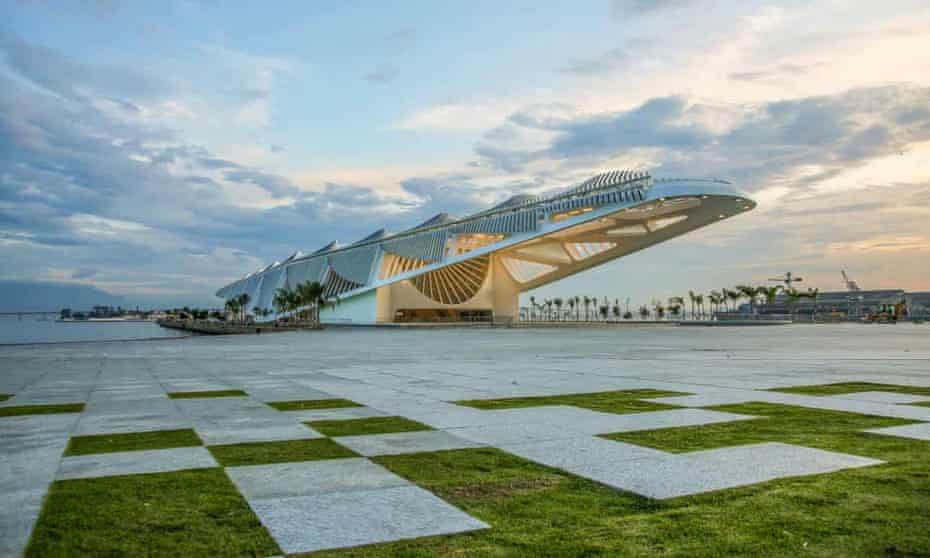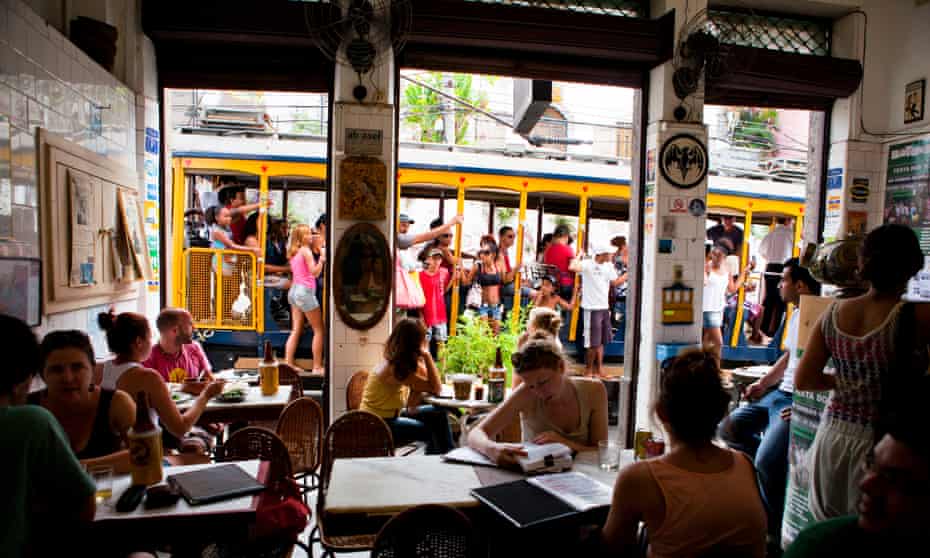For millions of people around the world, this Friday evening should be the most joyous of the year – the first night of carnival. In a normal year, brass and steel pan bands in New Orleans and Trinidad would be polishing their instruments after months of rehearsals, and mardi gras paraders pulling on spangled costumes before hitting the streets. And Cariocas, residents of Rio de Janeiro, would be limbering up for what they proudly call “the world’s biggest party”.
Not this year, sadly: it’s been cancelled everywhere from Cádiz to the Caribbean. What a shame. Carnival would be the perfect antidote to our current woes: five carefree nights of dancing, music and drinking … social distancing be damned.
Rio stages the ultimate artistic expression of carnaval, a ridiculously grandiose spectacle of glitz and glitter to a booming samba soundtrack. Dozens of samba schools across the city spend all year preparing for their time in the spotlight, employing hundreds of designers, painters, musicians, seamstresses, sculptors and mechanics – each preparing a parade of around 4,000 revellers, who dance to the beat of a 300-strong bateria, or drumming band.
A year in the making for a 70-minute performance. Any longer and the samba school is docked points, for although each parade is a living work of art, the competition between them is as fierce as a Brazilian football match. Every aspect of the parade – the song, costumes, floats, carnival queens, dancing – is marked by a team of judges, and when the marks are announced on radio and TV on the last day of carnival, the city stops partying to hear the results.
There’ll be none of that this year, but there will be online action. Mangueira, one of Rio’s oldest samba schools – which has used carnival to stand up to President Bolsonaro’s absurd divisive rhetoric – will be hosting live virtual shows on YouTube on Sunday, Monday and Tuesday from 3pm (6pm GMT), with a small samba band and online voting for the best song of the year. Portela, another traditional school and winner of a record 22 carnival parades, will be playing old-school samba live at midday (3pm GMT) on Sunday.

The samba schools parade in the 90,000-seat Sambódromo – a purpose-built 700-metre-long boulevard/stadium designed by Oscar Niemeyer, Brazil’s greatest architect. While this televised show grabs the headlines, it has become too overblown, expensive and touristy for many Cariocas, and in the last decade the popularity of street parties has exploded. At the heart of these are the hundreds of blocos, or street bands, who play all over town. They are a riot – free, inclusive and LGBT-friendly, with lots drag queens strutting their stuff.
Monobloco, which formed in 2000, now attracts tens of thousands in the city centre, but this year will be doing so virtually on Saturday (13 February) at 8.30pm (11.30 GMT). Another worth checking out is Sargento Pimenta (Sergeant Pepper), formed by a Beatles nut, who play samba versions of the band’s songs. And here’s a list of other virtual events, though you may have to use Google Translate to work out what’s going on.
See

A few years ago I spent four days walking across Rio – one of the most exhilarating travel experiences of my life. As I said then: “Thanks to its unique topography and gobsmacking natural beauty, it offers a city walk like nowhere else on Earth, taking in a lake, mountains, two of the world’s most famous beaches and some of Brazil’s last remaining virgin Atlantic rainforest, not to mention colonial villages and the biggest favela in Latin America – all within the city limits.”
Everywhere you turn there’s a spectacular view, from the top of a mountain or hillside favela, to two-mile crescents of sand and sparkling sea. You Visit’s hi-res virtual guide offers a beautiful overview, with interactive vistas and photos of Christ the Redeemer, Sugarloaf, Ipanema and more, all bathed in tropical sunshine.
One of the city’s most interesting recent cultural additions is the Museu do Amanhã (Museum of Tomorrow), a spectacular contemporary science centre jutting into the sky from the old port. It’s dedicated to exploring the planet’s sustainability issues “tomorrow” rather than the usual, vague “in the future”. Have a look around.

Rio is so famous for its beaches, carnival, football and general gorgeousness that, even though the capital was transferred to Brasília in 1960 and São Paulo is twice as big, it’s easy to forget that it remains Brazil’s cultural capital.
If you want a blast of virtual sunshine – or to torture yourself – here’s a livestream of Copacabana beach in the height of summer. And if you’re thinking of going to Brazil once restrictions have been lifted, specialist operator Journey Latin America’s new Virtual Travel Club will be hosting a live evening talk and Q&A on the country via Zoom on 8 June (free, register online).
Listen
Asking a Brazilian to select a music that represents their country is as futile as asking an American to do the same. The musical heritages of the Americas’ two most populous and diverse nations are equally rich and varied. Both originate in Africa and were incubated by slavery – sugarcane fields were to samba what cotton plantations were to the blues. The two Brazilian genres most famous outside the country, samba, and from it bossa nova, both have their roots in Rio (though the seeds of the former may have been planted in the state of Bahia – it’s contentious), and there are a dozen other genres to listen to besides.
They’re more than 10 years old now, but I recommend the fun and funky Favela Chic: Postonove compilations as a taster of Brazilian music. They span decades and take in everything from hip-hop and traditional samba to Brazilian funk and jazz, curating greats like Jorge Ben and Beth Carvalho via Seu Jorge to rappers and DJs.
To find out what’s happening on the music scene now, I spoke to producer, writer and multi-instrumentalist Alexandre Kassin, who has a show on Gilles Peterson’s Worldwide FM station. Like all Cariocas, at this time of year Kassin would usually be immersed in carnival, quite literally. “From my house in the Botafogo neighbourhood I can hear three or four different blocos playing at the same time,” he says.
In the run up to carnival his Orquestra Imperial, “a Brazilian answer to the big swing bands” usually plays weekly gigs in the city’s clubs, such as the “very cool” Manouche near the stunning Botanical Gardens.
Kassin’s list of Rio musicians worth checking out includes Ana Frango Elétrico (who mashes up garage rock with bossa nova); Alberto Continentino (“one of the best bass players in the world and an unbelievable songwriter”); Negro Leo (“a super-cool songwriter with a unique style”); Antonio Neves (drummer, trombonist and pretty wild by the sound of him); and Priscila Tossan (“I play with her band, an incredible singer”).
For an idea of what carnival feels like, listen to Fanfarra, on Sergio Mendes’ Grammy-winning album, Brasileiro. This is the only recording I know that comes close to the chest-pounding, hairs-on-neck-raising intensity of a 300-strong bateria. Surely Kassin knows of more, but he says: “It is almost impossible to capture that sound and energy in a studio [Mendes recorded in a car park], so when they make a record bands only use a handful of drummers. But I’d like to try to record a whole bateria one day.” He should – the world deserves to hear it.
Read

Rio’s complexities and curiosities are Brazil’s, and any understanding of the city should begin with an overview of the country – through a book like Joseph Page’s witty and incisive The Brazilians, or Misha Glenny’s excellent podcast, The Invention of Brazil.
No novel exposes Brazil’s soul or the origins of Rio’s problems like Peruvian Nobel prize winner, Mario Vargas Llosa’s epic The War of the End of The World. Set not in Rio but in the desert of Brazil’s north-east (and based on real events recorded in Rebellion in the Backlands, by Rio journalist Euclides da Cunha), it tells the story of a 19th-century millenarian rebellion among the poor and marginalised of Canudos, which was brutally crushed, after the first three attempts were heroically defeated, by a huge army dispatched from Rio.
After the war, the mostly black mercenary troops and surviving renegades were abandoned and migrated south to settle in shantytowns in Rio’s hills. They called them favelas, after a flower that had grown on the Canudos battlefields. And so Rio’s tragedy began, and continues, as a civil war – between the cosseted political elite and the alienatedfavela majority.
“Criminality in Brazil exists because of racism and an unequal distribution of wealth, which has endured for years,” says Paulo Lins, who grew up in one of Rio’s roughest neighbourhoods. He wrote about it in City of God, which in exquisite, lyrical prose, charts the brutal, violent reality of the social and racial divide and the romantic hope-against-all-odds which are the antinomy in Rio’s soul.

The charting of this antinomy has been a theme in Carioca literature since the 1800s, when Machado de Assis was born at the bottom of the pyramid – to a freed slave. Through sheer intellect he rose to become Brazil’s most celebrated writer. The literary prize that bears his name remains the most prestigious in the country. His masterpiece, The Posthumous Memoirs of Brás Cubas, is a blisteringly funny attack on Rio society. Clarice Lispector’s The Hour of the Star is the book’s 20th-century sibling – telling the story of a young migrant from the impoverished north-east whose dreams of a better life are extinguished by prejudice and sexism.
It’s not all misery. Former Guardian correspondent Alex Bellos’s masterful Futebol: The Brazilian Way of Life is more than a book about the beautiful game: it’s a love story to all that is good and bad about Rio, and Brazil as a whole – the camaraderie and corruption, the vivacity and venality, the humour, hubris and sheer love of life that underpin everything Carioca.
Watch

You won’t find the best films about Rio on the city’s tourist board website. While Hollywood film-makers have been Flying Down to Rio since the 1930s to make use of its ravishing backdrop, most Brazilian directors focus their lenses on the brutal realities of Brazilian society and poverty-stricken urban life.
We’ve already mentioned the book City of God, but Fernando Meirelles’s 2002 film adaptation tops most lists of best films about Rio. Set in a drug-riddled favela where casual murder is a way of life, it is told through the eyes of its children, played mostly by amateur actors. It is extremely violent, with a body count that rivals Rambo, but also has the same cool swagger of Goodfellas or Trainspotting.
Walter Salles, one of the country’s most successful directors, was Oscar-nominated for Central Station (1998), a film about a former school teacher who writes letters home for the city’s illiterate migrants, including a young orphaned boy whom she reluctantly takes under her wing for a journey to the impoverished north-east of Brazil in search of his father. It’s a beautiful piece of storytelling that avoids the saccharine adult-child bonding cliches the plot might suggest, and showcases the country’s vast landscapes.
Two other groundbreaking Rio films made in the 1950s are worth seeking out. Rio 40 Graus (Rio 100 Degrees F, 1955) is a neo-realism semi-documentary that follows boys who sell peanuts on the beach and at football stadiums, which was originally banned in Brazil for its frank depiction of the poor. The second is Orfeu Negro (Black Orpheus, 1959), which transposes the Greek legend of Orpheus and Eurydice to a favela during carnival. Its bossa nova soundtrack introduced the world to the then emerging genre.
A more rose-tinted take on the birth of bossa nova is now streaming on Netflix. The Girls from Ipanema (yes, really) is a glossy period drama that follows a young woman who, after being abandoned by her husband, opens a bossa nova club. Also on Netflix is the more sobering The Edge of Democracy, a 2019 documentary that explores how Brazilian politics has become so polarised and ugly that, after emerging from 25 years of military dictatorship in 1989, is falling back into fascism. And rapper and activist Emicida’s AmarElo: It’s All For Yesterday celebrates the rich legacy of black Brazilian culture in a country where “black lives matter less”.
Taste

As I write this at my kitchen table in snowy London, I can’t help but wish I was sitting outside one of these 10 fantastic botecos, or local bars in the searing heat of Rio sinking ice-cold beers. One reader wrote to tell me he’d used my list as guide to the city when he visited. That wasn’t my intention, but what a great idea! They are all city institutions in cool parts of town.
If you’re not in Rio either, console yourself with a caipirinha. Brazil’s luscious national drink has more of a kick than other classic lime-based cocktails, like the daiquiri and mojito, a result of the cachaça spirit being distilled from fermented sugarcane juice. This is a good recipe, though you may want to reduce the amount of sugar slightly – Brazilians usually have a sweet tooth. If you can’t get hold of cachaça, make a caipiroska – the same drink but with vodka. It doesn’t have the oomph of a caipirinha, but it does the job.
Brazil also has a national dish – feijoada, a black bean and pork stew served with toasted manioc flour, rice, collard greens and oranges. According to legend, feijoada has its origins in slavery, with slaves concocting the hearty dish from black beans and leftover pigs’ feet, ears, tails and so on. The truth isn’t quite as romantic; it originates in Portugal and is related to French cassoulet and Asturian fabada.
This Guardian recipe is excellent. Feijoada is usually eaten at a celebration – and in Rio that means carnival season. When I lived in Brazil, I’d make a big pot to keep me going through carnival – protein heavy, it’s ideal for both soaking up a hangover and filling the tank before an all-nighter.
This meaty feast is a vegetarian’s idea of hell, but my veggie version is delicious, too. Just leave the meat out of the above recipe and up the seasoning, herbs and spices (black beans don’t have as much flavour as lentils), and for the last 20 minutes or so place chunks of potato, carrot, pumpkin and sweet potato on top of the beans to steam in the inky broth.
Culinary Backstreets is a good guide to Rio food scene.
• Read section written by Alex Robinson, a travel writer specialising in Latin America





